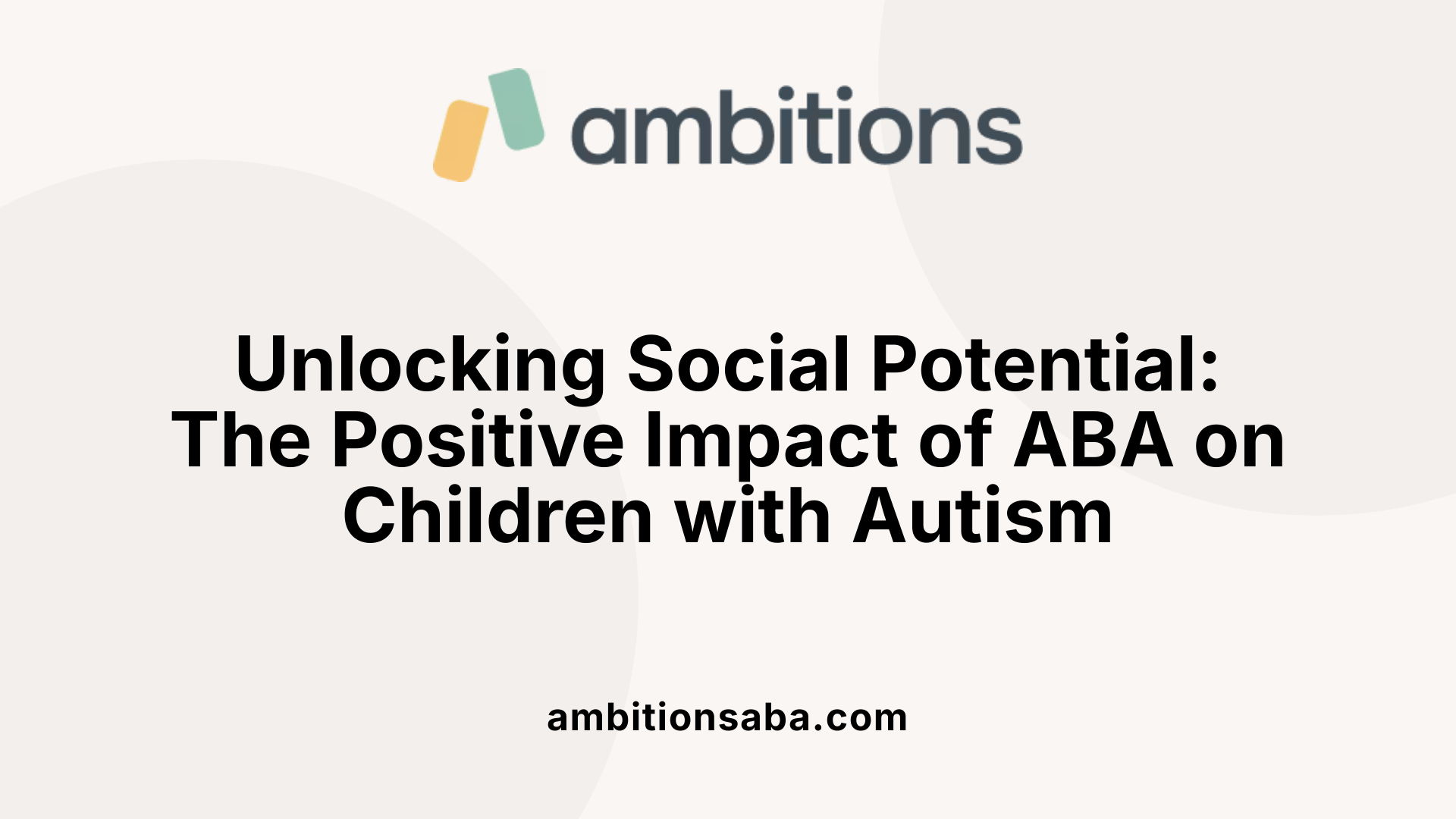In this article, we will delve into the question of whether David Sacks is autistic, explore the broader context of autism in the workplace, and discuss the implications of such revelations.
Introduction
Applied Behavior Analysis (ABA) therapy is gaining recognition for its role in improving social functionalities in children with autism. At its core, ABA therapy employs a methodical approach to enhance communication, interaction, and emotional understanding by focusing on vital social behaviors. Let's delve into how ABA therapy equips children with essential social skills, fostering their ability to engage more effectively with their surroundings.
Decoding ABA Therapy

What Does ABA Therapy Stand For?
ABA therapy stands for Applied Behavior Analysis, a therapeutic approach rooted in the science of learning and behavior. This method primarily assists children, particularly those with autism, in learning new skills and reducing problematic behaviors. Using techniques such as positive reinforcement, ABA encourages desired actions while systematically assessing and adjusting behaviors based on their antecedents and consequences.
Customization and Evidence-Based Approach
A standout feature of ABA therapy is its highly customizable nature. Each child's unique needs, strengths, and interests are taken into account, ensuring the therapy remains relevant and effective. Practitioners create individualized treatment plans after conducting comprehensive assessments.
Research has shown the efficacy of ABA, not just in teaching vital social skills but also in reducing challenging behaviors. Its applications extend beyond autism, serving individuals with various developmental and behavioral issues, including ADHD, OCD, and PTSD.
Overview of ABA Applications
| Application | Description | Benefits |
|---|---|---|
| Communication Skills | Enhances expressive and receptive language abilities. | Improved relationships and reduced frustration. |
| Social Skills Development | Teaches turn-taking, sharing, and empathetic responses. | Better peer interactions and friendships. |
| Daily Living Skills | Focuses on practical skills like personal hygiene and getting dressed. | Increased independence and self-care. |
| Behavioral Management | Uses reinforcement techniques to diminish disruptive behaviors. | Greater social acceptance and confidence. |
This structured, evidence-based approach not only enriches communication and social skills but is adaptable to meet diverse needs, making ABA therapy a comprehensive option for many.
Transformative Effects of ABA Therapy on Social Skills

How does ABA therapy help children with autism?
ABA therapy supports children with autism in multiple ways by focusing on behavior management and learning improvement. Through structured interventions, it enhances positive behaviors while minimizing harmful ones.
- Positive Reinforcement: This core strategy allows children to be rewarded for desirable behaviors, thus promoting their repetition in various social settings.
- Functional Behavior Assessment: Before therapy starts, practitioners assess a child's social skill deficits and strengths, which lays the groundwork for tailored treatment plans.
- Individualized Approach: Programs are designed to meet each child’s specific communication and social interaction needs, ensuring relevance and applicability in everyday life.
These interventions can occur in diverse environments, allowing children to generalize skills and maintain engagement with peers. Research underscores ABA as an evidence-based practice that significantly improves communication and social skills for children with autism, especially when initiated early.
How does ABA therapy improve social skills?
ABA therapy enhances social skills through targeted methods that build on a child's strengths. Key practices include role-playing, social stories, and modeling.
- Role-playing: Children practice social scenarios in simulated environments to learn appropriate responses.
- Social Stories: These provide context for social situations, helping children understand expected behaviors.
- Modeling: Therapists demonstrate proper social interactions, allowing children to observe and imitate.
Overall, ABA therapy focuses on fostering empathy and understanding others' perspectives. Children learn crucial nonverbal communication cues like facial expressions and body language, aiding in emotional regulation and connectivity with peers. By continually reinforcing positive behaviors, these strategies lead to lasting improvements in social engagement and a reduction in negative behaviors, encouraging children to develop meaningful relationships.
Techniques Employed in ABA Therapy to Enhance Social Skills
What are some ABA therapy techniques used to teach social skills?
ABA therapy incorporates a variety of techniques specifically designed to develop social skills in children with autism. Below are some of the prominent methods utilized:
Role-Playing and Modeling:
Children engage in role-playing to mimic social scenarios, practicing responses in a safe environment. Modeling involves therapists or peers demonstrating appropriate behaviors, allowing children to observe and imitate.Reinforcement Strategies:
Positive reinforcement is a central tenet of ABA, encouraging children to repeat desired social behaviors by rewarding them. This approach motivates children to engage positively with peers.Peer-Mediated Interventions:
Involving typically developing peers can enhance the learning experience. These peers provide support and context for practicing social skills in natural settings, promoting authentic interactions.Video Modeling:
This technique uses recorded social interactions to showcase appropriate behaviors. Children can watch these videos and then practice what they observe, reinforcing learning through visual aids.Natural Environment Training:
Practicing skills in real-world contexts—such as while at school or during play—allows children to apply ABA principles in everyday situations, making learning relevant and immediate.Scripting:
Providing pre-written dialogues can alleviate anxiety in social situations, helping children feel more prepared and confident to engage with their peers.
Overall, these carefully structured interventions enable children to navigate social contexts more effectively, fostering better relationships and communication.
The Importance of Social Interaction for Children with Autism
Why is social interaction important for children with autism?
Social interaction is crucial for children with autism because it helps them develop essential social skills that guide their interactions with others. Many children on the autism spectrum desire social engagement but may struggle with the complexities of social cues and participation. This makes structured social skills development particularly important.
ABA therapy utilizes strategies such as role-playing and modeling to teach children how to navigate social scenarios. By practicing these skills in a controlled environment, children learn effective communication and improve their ability to express their thoughts and feelings.
Programs like PEERS provide a supportive atmosphere where children practice social skills together. This practice not only enhances their self-awareness and self-esteem but also fosters the ability to form meaningful friendships. For instance, reciprocal conversations and active listening are core components of their training, which build empathy and understanding of others' perspectives.
Importance of building relationships
Building relationships is foundational for children with autism. Positive social interactions can significantly enhance their quality of life. Skills like turn-taking and sharing are nurtured through structured activities, leading to stronger engagement with peers.
Developing self-esteem and empathy
As children practice social skills through methods like peer-mediated interventions and Natural Environment Training, they experience techniques that help them express emotions constructively. This development not only builds self-esteem but also helps them relate better to their peers' feelings, thereby enhancing their empathy.
Long-term integration into the community
Long-term, effective social skills training emphasizes community integration. Enhanced communication abilities significantly aid children with autism in developing the confidence necessary for navigating social environments. By equipping them with critical life skills early on, such as responding to social cues and engaging in reciprocal conversations, ABA therapy plays a vital role in preparing them for future interactions and relationships in their communities.
Role of Positive Reinforcement in ABA Therapy

Encouraging repetition of desired behaviors
Positive reinforcement plays a pivotal role in ABA therapy by promoting the repetition of desired behaviors. When children with autism receive immediate rewards—be it praise, stickers, or extra playtime—for demonstrating specific social skills, they are more likely to engage in those behaviors again. This strategy not only solidifies learning but also helps them recognize the value of positive social interactions.
Recognizing and rewarding achievements
A key aspect of ABA therapy is the systematic recognition of children’s achievements, no matter how small. Each success is acknowledged, reinforcing the behavior and encouraging children to strive for further accomplishments. This continual reinforcement helps children understand what behaviors are expected and the positive outcomes that arise from them, making social skills feel attainable and rewarding.
Building self-confidence through success
The cumulative effect of positive reinforcement is the enhancement of self-confidence among children with autism. As they consistently meet their goals and receive positive feedback, they develop a greater sense of self-efficacy. This newfound confidence can translate into improved social interactions, as children feel more capable and willing to engage with peers.
Addressing Language and Communication Through ABA

Impact on expressive and receptive language
ABA therapy directly targets language deficits in children with Autism Spectrum Disorder (ASD). By focusing on both expressive and receptive language skills, it employs various strategies to help children communicate more effectively. Techniques such as role-playing and social stories allow children to practice language skills in controlled settings. This practice not only improves their ability to express themselves but also enhances their comprehension of language used by others.
Nonverbal communication
A crucial aspect of social interactions is nonverbal communication, which includes understanding facial expressions and body language. ABA therapy emphasizes the importance of these nonverbal cues by helping children recognize different social signals. Through modeling and structured practice, children learn how such cues influence communication and relationship-building, making them more adept at engaging with peers.
Reduction of communication barriers
Children with autism often face challenges when trying to communicate, which can lead to frustration and social withdrawal. ABA therapy works to reduce these barriers by breaking down communication strategies into manageable steps. The use of positive reinforcement encourages children when they attempt to communicate, whether verbally or nonverbally. Additionally, ABA techniques facilitate natural peer interactions through group activities, instilling greater confidence and a willingness to engage with others.
| Technique | Description | Outcome |
|---|---|---|
| Role-playing | Practicing social scenarios in a safe environment. | Improved expressive language skills. |
| Positive reinforcement | Rewarding desired communicative behaviors. | Increased attempts to communicate. |
| Modeling | Observing peers or therapists demonstrate social skills. | Better understanding of social cues. |
Customization and Early Intervention in ABA Therapy

Tailoring ABA therapy to individual needs
ABA therapy is fundamentally personalized, ensuring that each child receives support tailored to their unique strengths and challenges. Practitioners start by conducting comprehensive assessments to identify specific social skill deficits. These findings are crucial in developing individualized treatment plans that align with the child’s everyday life, making the learning process more relevant and effective.
Importance of early intervention
Starting ABA therapy early, particularly before the age of six, plays a vital role in improving developmental outcomes. Research consistently shows that early intervention significantly enhances social skills, communication abilities, and emotional understanding in children with autism. The sooner these children begin therapy, the better equipped they are to navigate social environments and build meaningful relationships.
Assessments and individualized goals
Assessments in ABA therapy serve as the foundation for creating clear, targeted goals. These assessments break down complex skills into manageable parts, allowing therapists to set specific, trackable objectives for each child. This structured approach not only enhances learning but also keeps progress measurable, ensuring that interventions remain effective over time.
Conclusion
ABA therapy stands as a cornerstone for transforming the lives of children with autism by promoting positive social behaviors and skills. Through a combination of personalized interventions, structured learning, and reinforcement strategies, ABA enables children to navigate social complexities with confidence. It continues to be a dynamic, evidence-based approach that empowers children, improving their prospects for a fulfilling and engaging social experience.
References
- Applied Behavior Analysis (ABA) | Autism Speaks
- How ABA Therapy Can Improve Your Child's Life
- How ABA Therapy Helps Improve Social Skills in Children
- 6 Life-Changing Benefits of ABA Therapy for Children with Autism
- How ABA Therapy Helps With Social Skills
- Benefits of ABA Therapy for Children with Autism
- How ABA Therapy Improves Social Skills in Children With Autism

